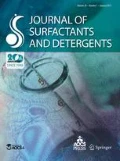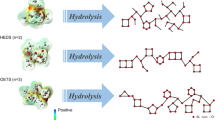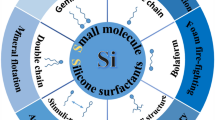Abstract
Gemini surfactants were synthesized by reaction of long-chain N-alkyl glucamines with epoxy resins. Analogous to the synthesis of gemini surfactns from long-chain N-alkyl glucamines and α, ω-diepoxides (1), the reaction in methanol at 70°C could be used to convert the starting materials selectively and almost quantitatively. N-Octyl glucamine, N-decyl glucamine, and N-dodecyl glucamine were combined with several epoxy resins, mainly technical glycidyl ethers of diols. Syntheses involving equimolar amounts of amine resulted in quantitative conversion of the epoxy resins, and epoxide and products could be isolated quantitatively by removing the solvent. Gemini surfactants having hydrophobic or hydrophilic spacers were preparared according to their structures and the hydrophilic properties of the epoxy resin. Surface tensions were measured, and foaming propertiers were examined to characterize surface-active properties of these surfactants. The more hydrophilic products were of particularly high surface activity. Tensiometric studies showed a reduction of surface tension to 30–34 mN/m and critical micelle concentrations in the range of 2–35 mg/L. Comparison of gemini surfactants from long-chain N-alkyl glucamines and diepoxides of α,ω-diolefins (chain lengths: C8, C9, C10, and C14) with those based on epoxy resins showed similar or lower surface activities using hydrophobic epoxy resins and much better surface-active properties using hydrophilic epoxy resins (e.g., based on glycerol). This, together with the easier availability, makes the epoxy resin-based products interesting surfactants. Products having very good surface-active properties are available, especially using glycidyl ether of aliphatic diols or glycerol.
Similar content being viewed by others
Abbreviations
- C20 :
-
efficiency=surfactant concentration corresponding to a reduction in surface tension of 20 mN/m in comparison with pure water
- CMC:
-
critical micelle concentration
- MALDI-TOF-MS:
-
matrix-assisted laser desorption/ionization-time of flight-mass spectrometry
- SEC:
-
size-exclusion chromatography
References
Warwel, S., F. Brüse, and H. Schier, Glucamine-Based Gemini Surfactants I: Gemini Surfactants from Long-Chain N-Alkyl Glucamines and α,ω-Diepoxides, J. Surfact. Deterg. 7:181 (2004)
Zana, R., Dimeric (gemini) Surfactants, in Novel Surfactants, Preparation, Application, Biodegradability, edited by K. Holmberg, Marcel Dekker, New York, 1998, p. 241.
Menger, F.M., and J.S. Keiper, Gemini-Surfactants, Angew. Chem. Int. Edn. 39:1906 (2000)
Rosen M.J., and D.J. Tracy, Gemini Surfactants, J. Surfact. Deterg. 1:547 (1998).
Kelkenberg, H., Detergentien auf Zuckerbasis, Tenside Surfactants Deterg. 25:8 (1988).
van Doren, H.A., Tatlor-made Carbohydrate Surfactants? Systematic Investigation into Structure-Property Relationship of N-Acyl N-Alkyl 1-Amino-1-deoxy-d-glucitols, in Carbohydrates as Organic Raw Materials III, edited by H. van Bekkum, H. Röper, and F. Voragen, VCH, Weinheim, 1996, p. 255.
Calcott, W.S., and R.G. Clarkson, Chemical Compounds, U.S. Patent 2060851 (1935).
Kelkenberg, H., Neue N-Alkylglykaminoverbindungen sowie ein Verfahren zur Herstellung und ihre Verwendung, E.P. 0396871 A2 (1990)
Warwel, S., F. Brüse, and B. Wiege, Surfactants from Long-Chain N-Alkyl Glucamines and ω-Epoxy Fatty Acid Esters, in Proceedings of Narossa 2002, Magdeburg, published as CD-ROM.
Warwel, S., and F. Brüse, Wasserlösliche Tenside auf Basis langkettiger N-Alkylglucamine, in Schriftenreihe “Nachwachsende Rohstoffe, “Nachwachsende Rohstoffe für die Chemie, 8. Symposium 2003, edited by Fachgentur Nachwachsende Rohsteffe, Landwirtschaftsverlag, Münster, 2003, p 500.
Warwel, S., M. Rüsch gen. Klaas, H. Schier, F. Brüse, and B. Wieg, Surfactants from Glucamines and α-Epoxides, Tenside Surfactants Deterg 38:7 (2000).
Warwel, S., M. Rüsch gen. Klaas, H. Schier, F. Brüse, and B. Wiege, Surfactants from Glucamines and ω-Epoxy Fatty Acid Esters, Eur. J. Lipid Sci. Technol. 103:133 (2001).
Warwel, S., F. Brüse, H. Schier, M. Rüsch gen. Klaas, and B. Wiege, Syntheses of Surfactants from Oleochemical Epoxides, Oléagineux Corps gras Lipides 8:57 (2001).
Warwel, S., and F. Brüse, Surgar-Based Surfactants and Functional Sugar Derivatives from Epoxide Ring Opening Reactions with Polyolamines, Fresenius Environ. Bull. 12:540 (2003).
Warwel, S., F. Brüse, and B. Wiege, Surfactants from Epoxides and Polyolamines Based on Disaccharides, Tenside Surfactants Deterg. 40:327 (2003)
Brüse, F., Tenside Polymerbausteine und Polymere aus Nachwachsenden Rohstoffen durch Epoxidringöffnungen mit Aminen und enzymatische Polykondensationen, Ph.D. Thesis, RWTH, Aachen, 2003
Author information
Authors and Affiliations
Corresponding author
About this article
Cite this article
Warwel, S., Brüse, F. Glucamine-based gemini surfactants II: Gemini surfactants from long-chain N-alkyl glucamines and epoxy resins. J Surfact Deterg 7, 187–193 (2004). https://doi.org/10.1007/s11743-004-0303-0
Received:
Accepted:
Issue Date:
DOI: https://doi.org/10.1007/s11743-004-0303-0




